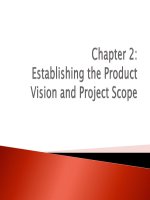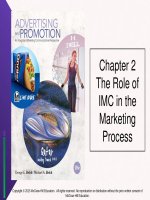Lecture Consumer behaviour: Chapter 2 - Cathy Neal, Pascale Quester, Del Hawkins
Bạn đang xem bản rút gọn của tài liệu. Xem và tải ngay bản đầy đủ của tài liệu tại đây (841.54 KB, 21 trang )
Chapter 2 Situational Influences
• Situations influence consumer behaviour
–
–
–
four main types of situations
can be categorised according to five main dimensions
implications for marketing strategy
Copyright 2004 McGraw-Hill Australia Pty Ltd
PPTs t/a Consumer Behaviour 4e by Neal, Quester, Hawkins
2–1
Topics
• The types of situational influence
• The nature of situational influence
• Dimensions of situation
–
–
–
–
–
Physical
Social
Time (temporal)
Task
Antecedent
• Situational influences and marketing strategy
Copyright 2004 McGraw-Hill Australia Pty Ltd
PPTs t/a Consumer Behaviour 4e by Neal, Quester, Hawkins
2–2
Types of Situation
• Communication situation
–
Where? Alone or with others? Surrounding noise?
• Purchase situation
–
Where? Alone or with others? In a hurry?
• Usage situation
–
With guests or alone? For pleasure or for work?
• Disposal situation
–
–
Before the next purchase? Trade-ins?
Or after the purchase, e.g. packaging
Copyright 2004 McGraw-Hill Australia Pty Ltd
PPTs t/a Consumer Behaviour 4e by Neal, Quester, Hawkins
2–3
Consumer Behaviour is
Product–Person–Situation Specific
2–4
The Role of Situation in Consumer Behaviour
2–5
Five Dimensions of
Situational Influence
• Physical surroundings
• Social surroundings
• Temporal perspectives
• Task definition
• Antecedent states
Copyright 2004 McGraw-Hill Australia Pty Ltd
PPTs t/a Consumer Behaviour 4e by Neal, Quester, Hawkins
2–6
Examples of Physical Surroundings
• Store location
• Interior decor
• Music
• Smell / aromas
• Temperature (air-conditioning or heating)
• Amount of choice provided
(by product category or across the categories)
Copyright 2004 McGraw-Hill Australia Pty Ltd
PPTs t/a Consumer Behaviour 4e by Neal, Quester, Hawkins
2–7
Typology of Service Environments
2–8
The Impact of Background Music
on Restaurant Patrons
2–9
Impact of Physical Density on Shopper Perceptions
2–10
Examples of Social Surroundings
• Types of customers in the store
• Queues and crowding
• Whether the consumer is likely to be known by
others/recognised
• Whether there are high-profile people/celebrities
shopping at that store
• Whether the product will be consumed privately or
in the presence of others
Copyright 2004 McGraw-Hill Australia Pty Ltd
PPTs t/a Consumer Behaviour 4e by Neal, Quester, Hawkins
2–11
The Impact of Social Situations on Desired Dessert Attributes
2–12
Examples of Temporal Influences
• Whether the product is seasonal
• Whether the product is urgently required
(snack between lectures)
• Time available for shopping limited/excess
(the product may be just an excuse for shopping)
• How long the previous product lasted or was
expected to last
Copyright 2004 McGraw-Hill Australia Pty Ltd
PPTs t/a Consumer Behaviour 4e by Neal, Quester, Hawkins
2–13
Examples of Task Influences
• Is the product utilitarian or used as a status
symbol?
• Is it a gift or for oneself?
• Must the product be long-lasting/tough?
(e.g. an everyday watch)
or decorative?
(e.g. a dress watch)
• Is the product intended for several uses?
(e.g. a family computer for study and internet
access)
Copyright 2004 McGraw-Hill Australia Pty Ltd
PPTs t/a Consumer Behaviour 4e by Neal, Quester, Hawkins
2–14
Buying Factors in Gift-Giving Purchase Situations
2–15
Examples of Antecedent States
• Moods
–
–
Feeling sad triggers buying sweets or going to a funny
movie
Feeling rejected triggers buying games software
• Momentary conditions
–
–
–
Can’t eat ice cream because teeth hurt
Can’t buy a book because left the credit card at home
Buy more groceries because hungry before shopping
Copyright 2004 McGraw-Hill Australia Pty Ltd
PPTs t/a Consumer Behaviour 4e by Neal, Quester, Hawkins
2–16
Ritual Situations
• A ritual situation can be described as a set of
interrelated behaviours that occur in a structured
format, that have symbolic meaning and that occur
in response to socially-defined occasions
• Important to marketers as they define consumption,
e.g. anniversaries, seasonal gifts
• Traditions and rituals being continued and
developed, e.g. Valentine's Day
Copyright 2004 McGraw-Hill Australia Pty Ltd
PPTs t/a Consumer Behaviour 4e by Neal, Quester, Hawkins
2–17
Situational Influences and
Marketing Strategy
• Developing a situational influence matrix
• Positioning the product based on situation
• Segmenting the market based on usage situation
–
–
–
alone
in combination with other segmentation variable
person/situation segmentation
Copyright 2004 McGraw-Hill Australia Pty Ltd
PPTs t/a Consumer Behaviour 4e by Neal, Quester, Hawkins
2–18
The Situational Influence Matrix
2–19
Usage Situations and Product Positioning
2–20
Next Lecture…
Chapter 3:
Problem Recognition
2–21









